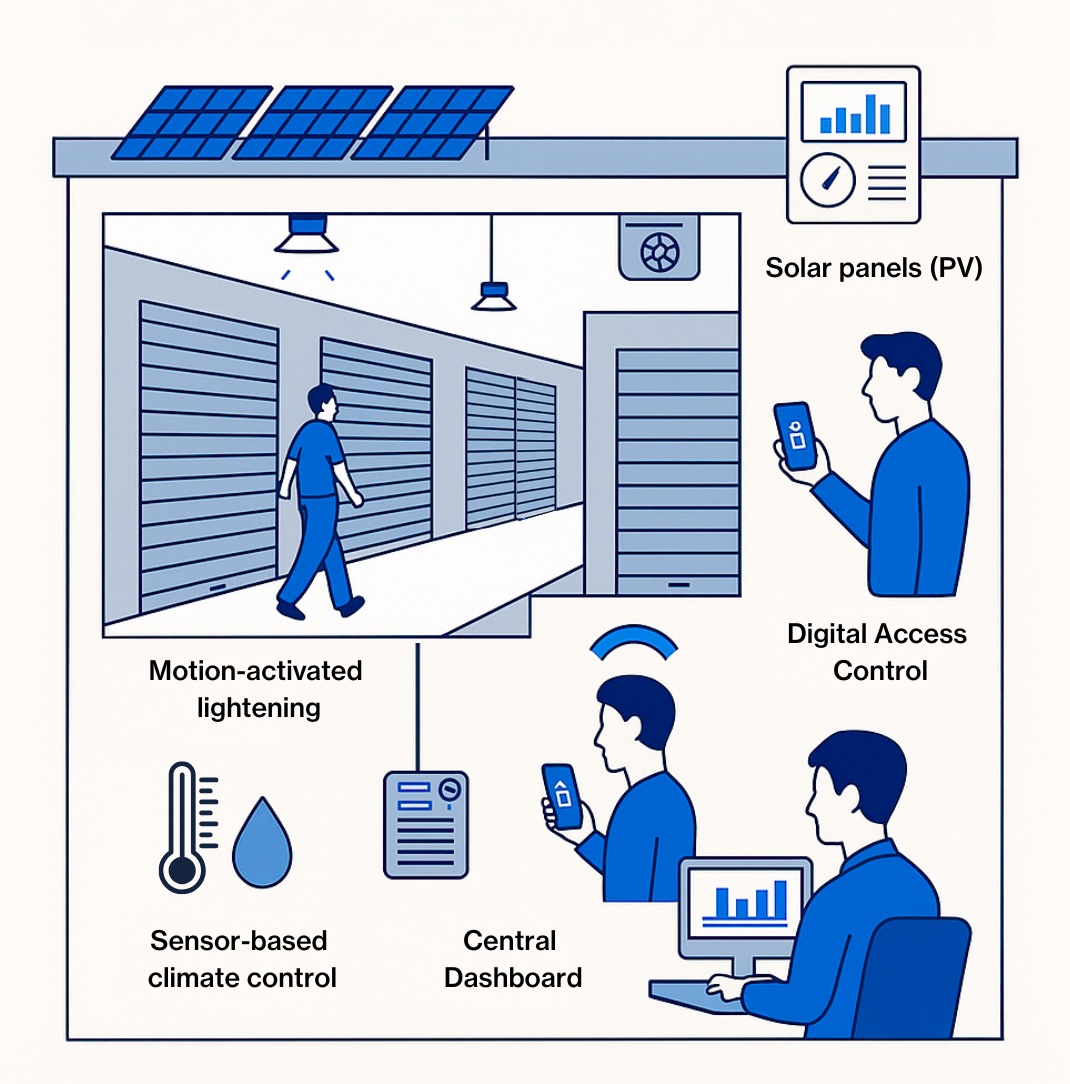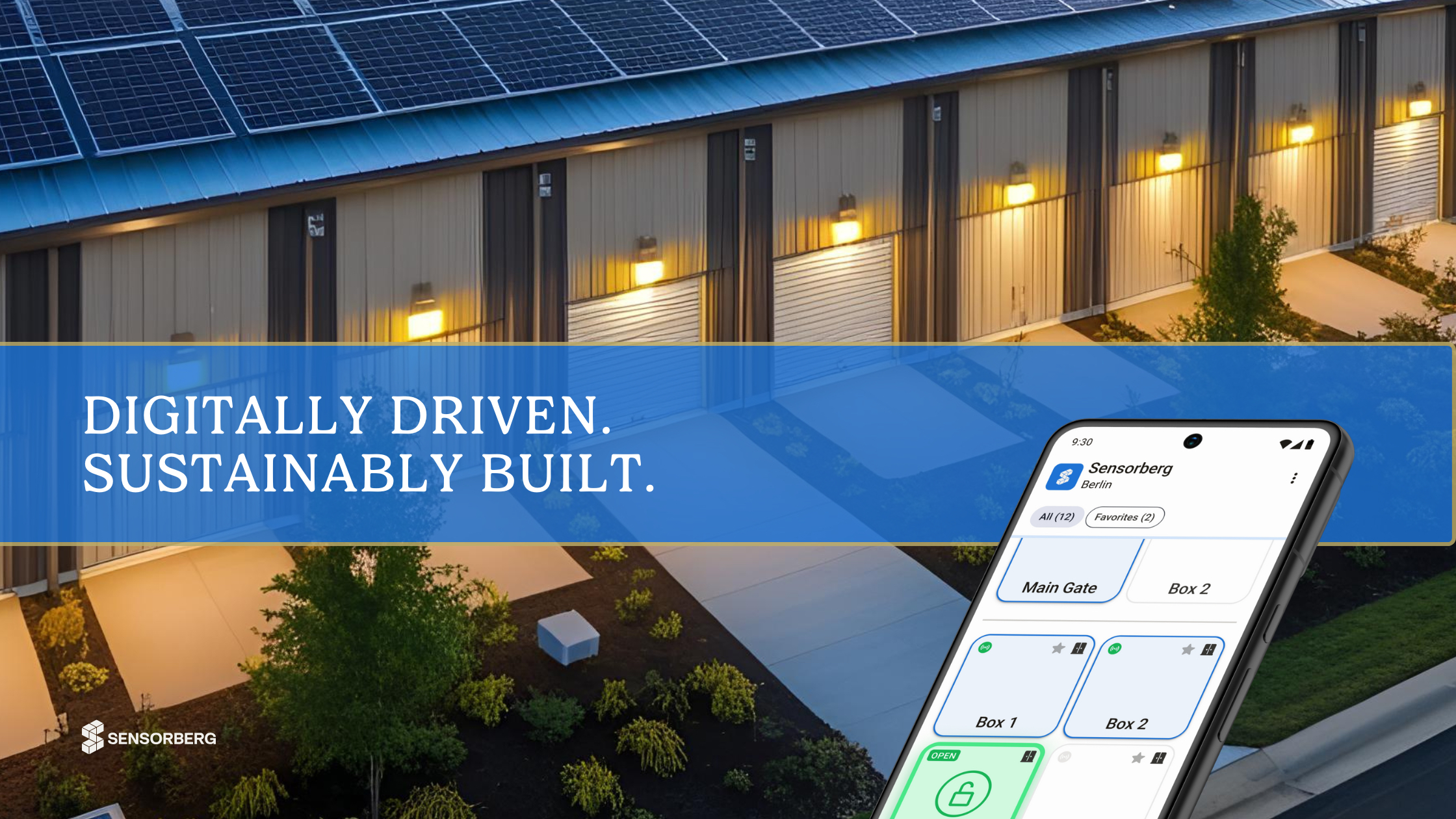Rising energy costs and climate change have pushed sustainability to the forefront of real estate. For high-consumption properties like offices, warehouses, and self-storage facilities—where 24/7 availability and lighting are standard—cutting CO₂ emissions without compromising functionality is a growing challenge.
In self-storage specifically, the need for continuous operation makes energy efficiency even more critical. At the same time, demand is shifting. Customers increasingly seek climate-conscious storage options, and the market is responding with flexible, digital-first self storage solutions that balance environmental responsibility with convenience.
This shift in consumer behaviour is matched by growing regulatory pressure. In Germany, for example, the Building Energy Act (GEG) and EU Taxonomy require strict energy performance documentation. Meeting these standards isn’t just about compliance—it’s about future-proofing your facility through energy savings and stronger ESG positioning.
That’s where smart technology steps in. Digital tools like sensor access systems, automated lighting, and climate control are no longer add-ons—they’re essential to cutting energy use and streamlining operations. Embracing access control self storage solutions is now a strategic decision, enabling operators to align with both market expectations and environmental goals.
📎 Related article: Smart Building Tech: The Key to ESG Compliance and Sustainable Operations
Why Energy Consumption Is a Growing Challenge in Self-Storage
Despite their relatively compact footprints, self storage facilities often consume large amounts of electricity. Continuous lighting, HVAC systems and/or surveillance technology like CCTV monitoring all require power—even when no one is present.
A major issue: many facilities operate in repurposed buildings not originally designed for self-storage. These sites often lack LED lighting, motion detectors, and automated systems. Instead, they run on outdated equipment, with manual HVAC settings and non-stop lighting, leading to high energy bills and inefficiencies.
Numbers tell the story. While warehouse-type buildings typically use around 120 kWh/m² per year, self-storage units can exceed that average due to specialized requirements. Meanwhile, GEG and EU Taxonomy requirements are raising the bar for energy performance and CO₂ transparency.
- Traditional lighting stays on 24/7.
- Modern lighting systems with elevator sensors, presence detectors, and smart access technology activate only when needed—cutting runtime by up to 80%.
Similarly, demand-driven climate control uses real-time temperature and humidity sensors to adjust conditions only when needed. A professional access control installation can centralise and automate these systems—ensuring everything operates only when necessary.
📎 Related article: How Access Control Systems Are Transforming Self-Storage
Mobile Access + Sensors: The Game Changers for Self-Storage?
Innovations in sensor technology and software are transforming self-storage into leaner, more energy-conscious operations. By integrating automated controls, sensor-driven inputs, and digital dashboards, facilities are shifting away from static, wasteful energy use toward responsive, demand-driven management. Central to this transformation are smart storage sensors and digital access control systems that synchronise lighting, HVAC, and security. Instead of running continuously, these systems activate only when activity is detected—significantly reducing energy waste while enhancing convenience for both operators and tenants. A key advancement is the adoption of mobile-based access control, which replaces physical keys and PINs. This enables operators to manage access permissions in real time and reduces the need for on-site staff—especially during overnight hours.
Providers like Sensorberg offer fully integrated, modular systems that connect access control with core building infrastructure such as HVAC. These solutions are designed to work seamlessly alongside third-party systems—including lighting—ensuring that equipment operates based on actual occupancy. At the center of this ecosystem is the Operator Control Board, an intuitive platform that aggregates access logs, traffic data, and automation tools to optimise how ventilation, entry, and other building functions interact.
This interconnected, data-rich environment allows operators to shift from reactive to predictive facility management—enhancing operational efficiency and supporting long-term sustainability goals. Climate control systems like Smart Metering also benefit from this intelligence, with temperature and humidity sensors triggering HVAC operations only when necessary—protecting sensitive stored goods while avoiding unnecessary energy consumption.
As these systems collect usage data over time, they offer powerful insights for further optimisation. By analysing peak access times and high-traffic areas, operators can fine-tune operational schedules, forecast maintenance needs, and implement targeted efficiency strategies. Ultimately, investing in professional access control installations not only advances sustainability but also unlocks new revenue streams—such as time-based access passes or premium monitoring services—while delivering measurable long-term cost savings and environmental benefits.
In the next chapter, we’ll dive into specific vendor solutions and explore how automated lighting control and solar integration further amplify these gains.
Smart Systems in Action: From Access to Analytics
Self storage facilities face increasing pressure to operate more sustainably while staying cost-effective. With energy prices climbing and ESG standards tightening, operators are turning to smart technologies to reduce consumption, cut CO₂ emissions, and boost efficiency.
Digital Access Control: The Foundation of Energy-Smart Storage
Modern digital access control systems replace physical keys and PIN pads with secure, app-based solutions. These systems allow operators to:
- Manage self storage access control remotely
- Grant and revoke user permissions in real time
- Reduce the need for on-site staff and routine checks
- Improve security and user experience
Because entry is digitally logged and automated, facilities consume energy only when in use—supporting both operational efficiency and environmental goals.
Automated Lighting and Climate Systems
Energy-intensive lighting and HVAC systems often run 24/7 in traditional setups. In contrast, smart access sensors and motion-based elevator sensors trigger systems only when someone is present:
- Lighting: Activated on demand, deactivates automatically
- Climate control: Adjusts based on real-time occupancy and sensor data
- Environmental protection: Stable conditions preserve sensitive goods like documents or electronics
These dynamic systems significantly cut energy waste while maintaining tenant comfort.

Photovoltaics and Smart Metering: Smarter Energy Use
Forward-looking operators are integrating photovoltaic (PV) systems and smart metering tools to align energy consumption with actual usage. Benefits include:
Using solar energy for lighting, sensors, or HVAC
Monitoring performance in real time via dashboards
Optimising load patterns based on occupancy trends
Smart energy management supports long-term cost control and compliance with ESG benchmarks. Combined with Sensorberg’s real-time monitoring and building automation tools, operators can make granular energy decisions based on occupancy, access logs, and environmental data.
ESG Compliance: Your Competitive Edge
Embracing smart building technology isn’t just eco-friendly—it drives profits and brand value.
💰Lower Operating Costs
Automating lighting, HVAC, and security cuts waste. Motion-based controls alone can trim utility bills by up to 30%, boosting NOI and per-unit ROI.
📈 Verifiable ESG Performance
Real-time data on access and consumption simplifies CO₂ reporting, aligning your facility with the EU Taxonomy and future regulations.
🌿 Brand Differentiation
Position your site as a “green” leader. Sustainable credentials attract eco-conscious tenants and investors who pay premiums for certified low-impact storage.
🛡️Peace of Mind
With tighter legislation on the horizon, smart systems future-proof your facility, minimising retrofit costs and compliance risk.
Self-Storage 4.0: The Smart Revolution is Here
The future of self-storage is smart, digital, and sustainable. Through automated access control, sensor-based climate systems, and intelligent energy management, operators can cut costs, meet regulatory demands, and align with rising ESG expectations.
Looking ahead, Self Storage 4.0 will be shaped by AI, IoT, and cloud-based automation—enabling predictive maintenance, real-time analytics, and fully adaptive facility control.
Smart technologies are no longer optional—they’re strategic. Operators who invest today are building facilities that are not only energy efficient, but also future-proof, profitable, and aligned with modern market demands. Are you ready for the upgrade?
Learn More About Sensorberg
Sensorberg delivers modular, fully integrated access control and building automation solutions designed specifically for the self storage industry. To discover how your facility can benefit from smarter, greener operations, visit www.sensorberg.com.


